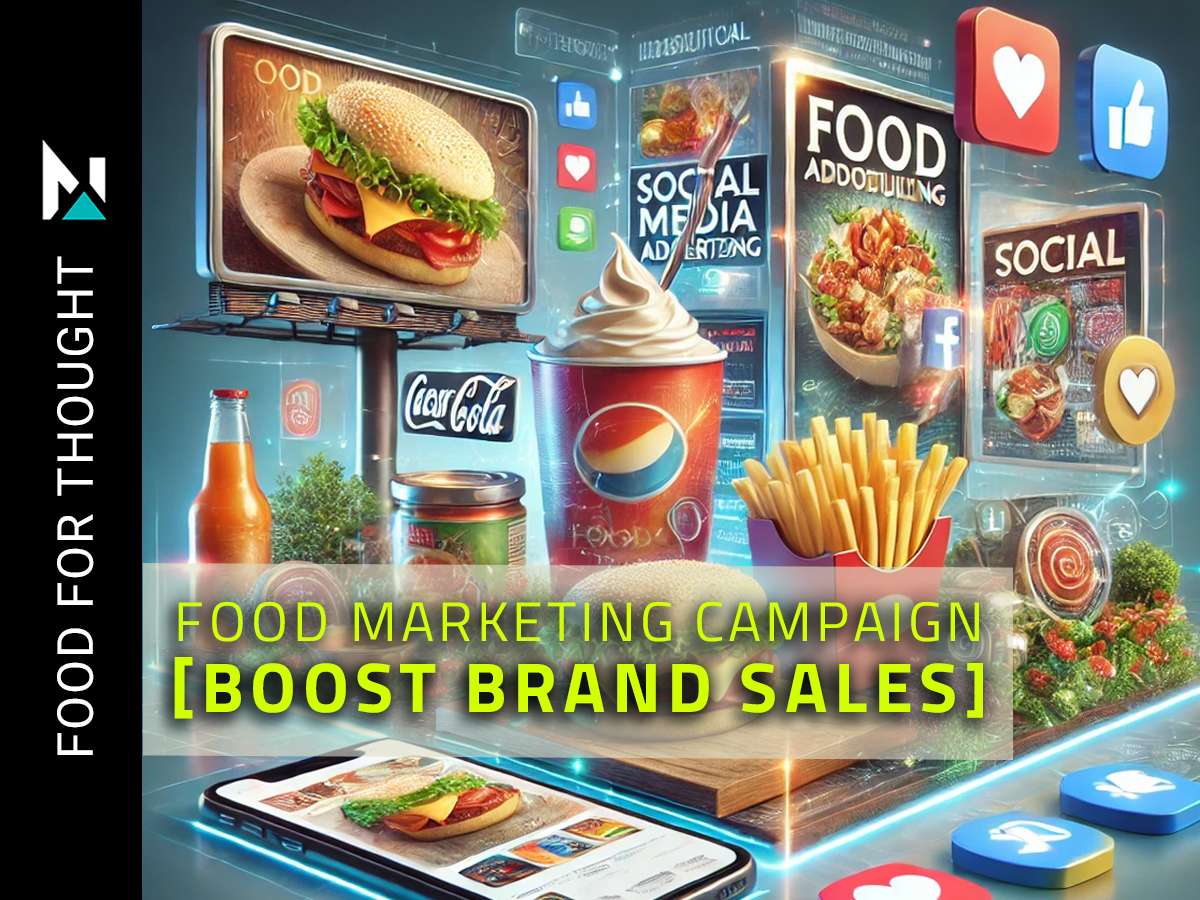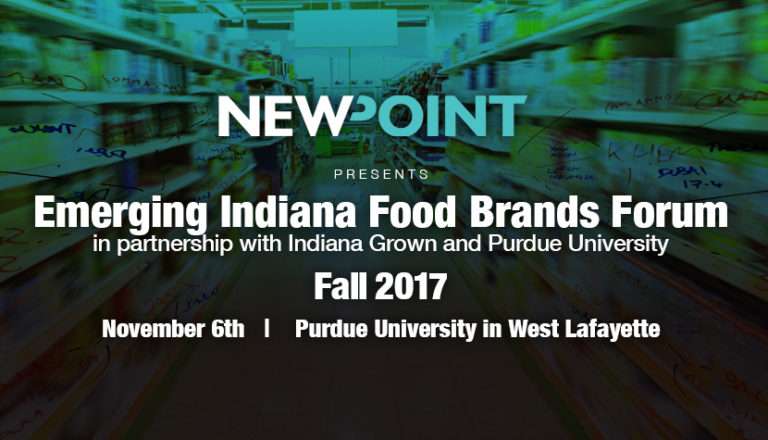Jul 25, 2024
Food Marketing Campaign to Boost Brand Sales
Why Your Brand Needs a Robust Food Marketing Campaign

The need for a food marketing campaign came up a few weeks ago when the owner of a small artisanal cheese company reached out to NewPoint. Evidently, she was frustrated when she shared that their cheese is amazing but barely staying afloat in this crowded market.
As we talked, it became clear that the cheese company had been relying solely on the quality of its product, neglecting the crucial role of marketing in today’s competitive food landscape. Her story wasn’t unique; we’ve seen countless food brands struggle to gain traction despite having excellent products.
Our feedback? The cheese might be the best in the world, but if no one knows about it, how can they find it, and more importantly, why would they buy it?”
Hence, the catalyst for this topic… This is for all the food brand owners who underestimate the power of a well-executed food marketing campaign. Because it isn’t just important for food brands – it’s essential for their very survival and success in this ever-evolving industry.
The Current State of Food Industry Marketing
The food industry’s marketing landscape is evolving rapidly, driven by digital transformation and changing consumer behaviors. Today’s successful food marketing campaigns leverage multi-channel strategies to engage audiences effectively. Social media platforms have become crucial for brand visibility and consumer interaction.
- E-commerce: E-commerce growth has shifted focus towards online marketing tactics and direct-to-consumer approaches. Food brands are increasingly utilizing data analytics to personalize marketing efforts and optimize campaign performance. Sustainability and transparency have emerged as key themes in recent food marketing campaigns.
- Video: Video content, particularly short-form videos, has gained prominence in food marketing strategies. Influencer partnerships continue to play a significant role in reaching target demographics. Many brands embrace cause-related marketing to align with consumers’ values and social concerns.
- Experiential marketing: Experiential marketing, such as pop-up events and interactive tastings, has become popular for creating memorable brand experiences. The COVID-19 pandemic accelerated the adoption of contactless marketing techniques and virtual engagement strategies.
Food brand campaigns now often incorporate augmented reality (AR) and virtual reality (VR) elements to enhance product visualization. Mobile-first marketing approaches have become essential due to increased smartphone usage for food-related searches and purchases.
Brands focus on creating compelling storytelling content to differentiate themselves in a saturated market. Also, health and wellness messaging has gained prominence in food marketing, reflecting growing consumer interest in these areas.
As the industry evolves, food marketing campaigns must adapt to new technologies and consumer preferences to remain effective and relevant.
Why Food Marketing Campaigns Matter for Food Brands
Food marketing campaigns are crucial for brands to thrive in today’s competitive marketplace. They serve as the cornerstone of brand visibility and consumer engagement. A well-executed food marketing campaign can significantly impact a brand’s success and market position.
Brand Strategy
- Brand awareness: Brand awareness is a primary benefit of effective food marketing campaigns. They introduce consumers to new products and reinforce existing brand identities. Through strategic messaging and visual elements, campaigns create lasting impressions in consumers’ minds.
- Differentiation: In a saturated market, differentiation is key to standing out. Marketing campaigns highlight unique selling propositions and brand values. They communicate what sets a food brand apart from competitors, influencing consumer choices.
- Emotional connections: Compelling campaigns can forge emotional connections with consumers. Brands can create lasting relationships by tapping into desires, nostalgia, or aspirations. These emotional bonds often translate into brand loyalty and repeat purchases.
- Consumer preferences: Adapting to changing consumer preferences is essential in the food industry. Marketing campaigns allow brands to showcase their responsiveness to trends. They can highlight new ingredients, health benefits, or sustainability efforts.
- Education: A food marketing campaign can also educate consumers about product features and benefits. This is particularly important for innovative or complex food products. Informed consumers are more likely to try and adopt new offerings.
Brand Business
- Sales: Sales growth is a direct outcome of successful marketing efforts. Campaigns drive consumer interest and create demand for products. They can introduce new offerings or revitalize interest in existing product lines.
- Go digital: Digital platforms have expanded the reach and impact of marketing campaigns. Social media, in particular, allows for direct engagement with consumers. Brands can foster communities and gather real-time feedback through these channels.
- Partnerships: Campaigns provide opportunities for cross-promotion and partnerships. Collaborations with influencers or complementary brands can expand audience reach. These partnerships often result in creative content that resonates with consumers.
- Analytics: Data-driven insights from marketing campaigns inform future strategies. Analytics help brands understand consumer behavior and preferences, which in turn guides product development and marketing decisions.
- Event & Seasonal: Seasonal and event-based marketing campaigns capitalize on specific occasions. They create urgency and relevance, encouraging timely purchases. Holiday-themed promotions, for example, can significantly boost sales during peak seasons.
- Brand reputation: Brand reputation management is another critical aspect of marketing campaigns. They allow companies to shape public perception and address concerns. Transparent communication builds trust and credibility with consumers.
Food Marketing Campaign: Drive Long-Term Brand Growth
In the competitive food industry, marketing campaigns are not just beneficial—they’re essential. They serve as the voice and face of a brand, communicating its values and offerings. A well-crafted food marketing campaign can be the difference between obscurity and market leadership.
Ultimately, food marketing campaigns drive long-term business growth. They build brand equity, expand market share, and increase customer lifetime value. For food brands, investing in strategic marketing is investing in their future success.
Key Components of a Successful Food Brand Campaign
A successful food brand marketing campaign comprises several key components that work in harmony to achieve desired outcomes. These elements are crucial for creating impactful strategies that resonate with target audiences and drive brand growth.
Define Brand Goals
Clear objectives and target audience identification form the foundation of any effective campaign. Defining specific, measurable goals provides direction and focus for all marketing efforts. Understanding the target demographic’s preferences, behaviors, and pain points is equally essential.
Create Your Brand Story
Developing a unique brand story and messaging is vital in a saturated market. This narrative should encapsulate the brand’s values, history, and unique selling propositions. Compelling storytelling creates emotional connections with consumers and differentiates the brand. It is important to realize consistency across all marketing touchpoints is key to reinforcing brand identity. From packaging to social media posts, maintaining a cohesive look and message strengthens brand recognition.
Define And Reach Your Brand’s Audience
- Channels: Selecting appropriate marketing channels is critical for reaching the intended audience effectively. A mix of traditional and digital platforms often yields the best results. Social media, email marketing, and content marketing are particularly effective for food brands.
- Imagery: Visual content plays a pivotal role in food marketing campaigns. High-quality food photography and appealing packaging design can significantly influence consumer perceptions and purchasing decisions. Investing in professional visuals is often worthwhile for food brands.
- Align with Your Core Consumer: Incorporating sustainability and transparency initiatives into marketing efforts is increasingly important. Consumers value brands that demonstrate environmental responsibility and ethical practices. Highlighting these aspects can enhance brand perception and loyalty.
- Experiential marketing, such as product sampling or interactive events, allows consumers to engage directly with the brand. These experiences create memorable impressions and foster stronger connections with the target audience.
- Leveraging influencer partnerships has become increasingly important in food marketing. Collaborating with food bloggers, chefs, or lifestyle influencers can expand reach and credibility. User-generated content also provides authentic endorsements and engagement opportunities.
A comprehensive food marketing campaign should also include a crisis communication plan. Being prepared to address potential issues or negative publicity is crucial for maintaining brand reputation.
Lastly, continuous evaluation and adaptation are essential for long-term success. Regular assessment of campaign performance allows for refinement of strategies and tactics. Staying agile and responsive to market changes ensures ongoing relevance and effectiveness.
By incorporating these key components, food brands can create robust marketing campaigns that drive awareness, engagement, and sales. A well-executed food marketing campaign has the power to elevate a brand’s position in the competitive food industry landscape.
Strategies for Effective Food Brand Marketing
Content Marketing
- Share recipes, cooking tips, and nutritional information.
- Create blog posts, videos, and infographics.
- Engage consumers with valuable, informative content.
Social Media Engagement
- Utilize platforms like Instagram, Facebook, and Twitter.
- Post high-quality images and videos of your products.
- Use hashtags to increase visibility and engagement.
- Conduct giveaways and contests to attract followers.
Email Marketing
- Build a subscriber list for newsletters and promotions.
- Personalize emails based on consumer preferences.
- Share updates on new products and special offers.
- Maintain regular communication to keep your brand top-of-mind.
Influencer Partnerships
- Collaborate with food bloggers, chefs, and lifestyle influencers.
- Leverage their audience to expand your reach.
- Create authentic content showcasing your products.
- Encourage influencers to share their personal experiences.
Event Marketing and Experiential Campaigns
- Host pop-up events, tastings, and cooking demonstrations.
- Create memorable experiences that engage consumers.
- Collect feedback and build relationships with attendees.
- Use events to launch new products and generate buzz.
Cause Marketing and Sustainability Initiatives
- Align your brand with social and environmental causes.
- Highlight sustainable practices and ethical sourcing.
- Partner with non-profits and community organizations.
- Promote your efforts through a food marketing campaign.
Seasonal and Holiday Promotions
- Plan campaigns around holidays and seasonal events.
- Create themed content and special offers.
- Tap into the festive spirit to boost sales.
- Use limited-time promotions to create urgency.
Data-Driven Strategies
- Use analytics to track campaign performance.
- Monitor consumer behavior and preferences.
- Adjust strategies based on data insights.
- Optimize campaigns for better results.
Packaging Design
- Invest in visually appealing and functional packaging.
- Ensure packaging reflects your brand identity.
- Use eco-friendly materials to appeal to conscious consumers.
- Highlight key product benefits on the packaging.
Product Placement
- Work with retailers to secure prime shelf space.
- Use end caps and checkout displays for visibility.
- Cross-promote with complementary brands.
- Ensure your products are easy to find and attractively presented.
User-Generated Content
- Encourage customers to share their experiences.
- Use branded hashtags to collect user content.
- Feature customer photos and reviews on your platforms.
- Build a community around your brand.
Mobile-First Marketing
- Optimize your website and content for mobile devices.
- Use mobile-friendly email templates.
- Leverage SMS marketing for timely updates.
- Ensure a seamless mobile shopping experience.
Video Marketing
- Create engaging video content for social media and YouTube.
- Showcase recipes, behind-the-scenes footage, and product features.
- Use live streaming for real-time engagement.
- Incorporate video ads into your food marketing campaign.
Loyalty Programs
- Implement rewards programs to encourage repeat purchases.
- Offer exclusive discounts and early access to new products.
- Personalize rewards based on customer preferences.
- Use loyalty programs to gather valuable consumer data.
By integrating these strategies, food brands can create a comprehensive and effective food marketing campaign. These approaches help build brand awareness, engage consumers, and drive sales, ensuring long-term success in the competitive food industry.
Measuring the Success of Your Marketing Campaign
Measuring the success of your food marketing campaign is crucial for optimizing performance and justifying investments. Key performance indicators (KPIs) provide quantifiable metrics to assess campaign effectiveness. These KPIs should align with your overall marketing objectives and business goals.
Common KPIs —valuable indicators of campaign success:
- Sales growth
- Market share
- Brand awareness
- Customer acquisition costs
- Social media engagement metrics
- Website traffic conversion rates
Tracking Success
Implementing robust tracking systems is essential for accurate measurement. Analytics tools like Google Analytics and social media insights offer valuable data on consumer behavior. CRM systems can track customer interactions and purchase patterns throughout the campaign lifecycle.
A/B testing is a powerful technique for optimizing campaign elements. Test different messaging, visuals, or offers to identify the most effective approaches. Continuously refine your strategies based on these insights to improve campaign performance.
Return on investment (ROI) is a critical metric for evaluating food marketing campaign success. Calculate ROI by comparing campaign costs to revenue generated or other value metrics. This analysis helps justify marketing expenditures and inform future budget allocations.
Customer feedback and surveys provide qualitative insights to complement quantitative data. These can reveal consumer perceptions and preferences that may not be apparent from numerical metrics alone. Regularly solicit and analyze customer feedback to refine your marketing approach.
Benchmarking against industry standards and competitors’ performance can provide context for your results. This comparison helps identify areas for improvement and opportunities for differentiation in your food marketing campaign.
Make a Big, Robust Brand Statement
The imperative for a robust food marketing campaign cannot be overstated in today’s competitive landscape. Many artisanal producers, like our cheese company client, rely solely on product quality for success. However, exceptional products alone cannot guarantee market visibility or consumer engagement in a saturated industry.
A well-executed food marketing campaign is not merely beneficial; it’s essential for brand survival and growth. It bridges the gap between product excellence and market recognition, enabling consumers to discover and appreciate your offerings. Without strategic marketing, even the finest products may languish in obscurity.
Speaking to food brand owners, marketing directors, and brand managers. Recognize the transformative power of comprehensive marketing strategies in the food industry. Embrace these approaches to elevate your brand’s visibility, engage your target audience, and drive sustainable growth.
Remember, in the ever-evolving food market, a strategic food marketing campaign is your key to not just surviving, but thriving. It’s time to harness the full potential of your brand and products through effective, targeted marketing efforts.
Is a brand campaign needed in your brand’s future? Contact the NewPoint Team itoday for a free, no-obligation conversation to see how we can make that happen.





